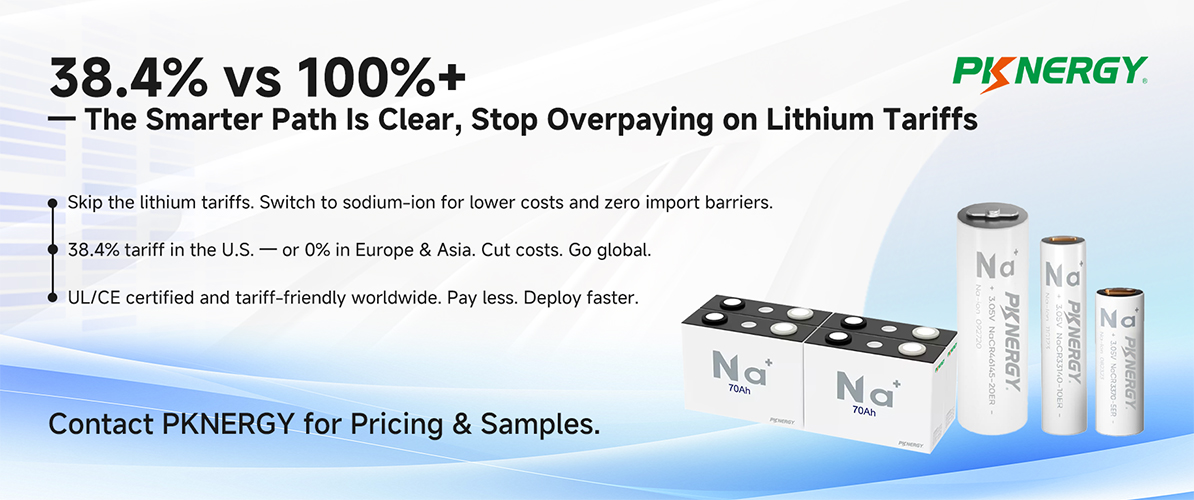Pourquoi l'ion sodium est une solution d'exportation intelligente
Alors que la demande mondiale de stockage d’énergie s’accélère, les fabricants sont confrontés à un choix crucial : continuer à payer des tarifs douaniers élevés sur les batteries lithium-ion ou explorer une voie d’exportation plus intelligente et plus rentable avec les batteries sodium-ion.
Alors que les batteries lithium-ion sont de plus en plus soumises à des droits de douane élevés, à des droits antidumping et à des restrictions d’importation strictes, les batteries sodium-ion évitent actuellement la plupart de ces barrières commerciales.
États-Unis : Sodium-ion 38,4 % contre Lithium-ion 100 %+
Aux États-Unis, les batteries lithium-ion sont soumises à un tarif d’importation combiné dépassant 100 %, prenant en compte les droits de base, les mesures antidumping et les tarifs de la section 301.
En revanche, les batteries sodium-ion sont actuellement soumises à un droit d’importation total de seulement 38,4 %, ce qui offre un avantage de coût significatif aux exportateurs.
Emporter:Aux États-Unis, les batteries sodium-ion sont taxées à près d'un tiers du taux des batteries lithium-ion.
Union européenne : 0 % de droits de douane pour le sodium-ion, droits élevés pour le lithium
L'Union européenne a imposé une série de restrictions commerciales sur les batteries lithium-ion chinoises, notamment :
-
Droits antidumping et compensateurs
-
Exigences en matière de traçabilité et de durabilité
-
Inspections douanières et charges documentaires
En revanche,les batteries sodium-ion bénéficient actuellement de droits de douane nuls dans l'UE, sans aucune mesure antidumping en place.
Emporter:L’exportation d’ions sodium vers l’UE est actuellement exemptée de droits de douane et se heurte à moins d’obstacles politiques.
Asie : barrières à l'importation minimales ou inexistantes
Les principaux marchés asiatiques, dont l'Inde, la Corée du Sud et l'Asie du Sud-Est, n'ont pas imposé de droits de douane significatifs sur les batteries sodium-ion. La plupart des pays maintiennentdroits d'importation nuls ou faiblessur les produits à base d'ions sodium.
Dans le même temps, les batteries au lithium font souvent l’objet d’une surveillance accrue ou d’un contrôle réglementaire dans ces régions.
Emporter:Les batteries sodium-ion sont bien accueillies dans toute l’Asie avec des droits d’importation faibles, voire nuls.
Sodium-ion vs Lithium-ion : avantage à l'exportation en un coup d'œil
| Fonctionnalité | Batterie sodium-ion | Batterie lithium-ion |
|---|---|---|
| Tarif américain | ~38,4% | 100%+ |
| Tarif de l'UE | 0% | Droits antidumping élevés |
| Tarif asiatique | 0–5% | Plus haut |
| Pression politique | Faible | Haut |
| Tendance des coûts | En baisse | Croissant |
| Sécurité et environnement | Plus sûr et plus écologique | Risque d'incendie/thermique |
Comment élaborer une stratégie d'exportation d'ions sodium
Passer au sodium-ion ne se contente pas de réduire les coûts : cela ouvre également de nouvelles perspectives sur des marchés internationaux clés. Voici comment démarrer :
-
Évaluez vos régions d'exportation
Privilégiez les destinations comme l’UE et l’Asie du Sud-Est avec des taxes d’importation minimales. -
Tirer parti des avantages de la conformité
Les batteries sodium-ion s’alignent plus facilement sur les politiques d’approvisionnement respectueuses de l’environnement et nécessitent souvent moins de certification. -
Choisissez le bon partenaire
Travaillez avec un fabricant d'ions sodium expérimenté dans la logistique internationale et la conformité réglementaire.
Conclusion : Exportez intelligemment. Choisissez l’ion sodium.
Les batteries sodium-ion représentent une opportunité rare pour les exportateurs mondiaux :des barrières commerciales plus faibles, des pressions sur les coûts réduites et un intérêt croissant des acheteurs—alors que le lithium-ion fait face à une surveillance réglementaire croissante et à des droits plus élevés.
Ne payez pas trop cher les tarifs du lithium.
Passez à l'ion sodium. Exportez intelligemment.
Contactez-nous dès aujourd’hui pour élaborer votre stratégie d’exportation d’ions sodium.
Date de publication : 23 avril 2025

